A bipartisan coalition of Western states is floating a regionalized model for identifying wetlands potentially subject to the Clean Water Act (CWA) as the Biden administration crafts a new definition of “waters of the United States” (WOTUS) under the law, urging regulators to adopt a flexible approach and to conduct “meaningful consultation” with states.
The Western States Water Council (WSWC) met with EPA, Army Corps of Engineers and White House Office of Management and Budget (OMB) officials Nov. 8 on their interagency review of the forthcoming WOTUS rule, and presented a white paper outlining what the state group says would be scientific and practical benefits of a regional approach — though it stops short of making explicit policy recommendations.
“Regions used for WOTUS implementation need to capture the most important attributes and differences across regions while ensuring that the regional scheme can be practically implemented by both federal regulatory agencies and states,” reads the white paper, titled “Applicability of regional classification schemes and analytical tools to regional definitions of [WOTUS].”
It memorializes and expands on discussions at a workshop series on WOTUS convened by WSWC in the summer of 2022, including representatives from 16 states and “several federal agencies,” shortly before EPA and the Corps sent their final rule establishing an interim WOTUS definition to OMB for review in September.
The paper also notes that the definition of WOTUS has been and will continue to be influenced by the Supreme Court — a nod to the pending high court case Sackett v. EPA, which went to oral argument in October and will likely be decided in 2023. “Over time, Supreme Court decisions have made clear that the jurisdictional scope of the CWA is something more than traditional navigable waters, but something less than all waters,” it says


